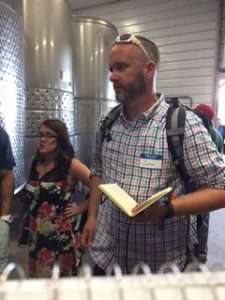
TasteCamp organizer Lenn Thompson
TasteCamp, an annual “wine camp” event organized by Long Island-based wine writer Lenn Thompson of The Cork Report, is open to the wine media who pay to attend a long weekend in the wine country of a specific region. The eight years old TasteCamp brought 33 attendees from June 8-11th to Maryland. Attendees ranged from Washington Post wine columnist Dave McIntyre to Hudson Valley winery owner and East Coast Wine Blog author Carlo Devito, to Executive Director of the American Wine Society David Falchek.
“The idea [of TasteCamp] is simply to immerse a group of open-minded writers and trade folks in a region that is new to them. We try to get as many wines in front of the group as possible over a couple days. You can’t tell the whole story about a state’s wine that quickly, but you can at least begin the conversation,” explains Thompson.
The event began in a wheat field called Burnt Hill, a 117 acre property with a fine view southwest to the Potomac recently purchased by Old Westminster Winery, where they had dug two soil pits to illustrate the well-drained, shale loam soils that they feel will make superior red wines, and even plan to plant pinot noir. The wheat plant roots indeed had grown down into the fine, loose soil, and constant breezes promised optimal conditions for reduced fungal disease pressure. The field was planted to wheat to create organic hummus below the surface to nourish the grapevine roots.
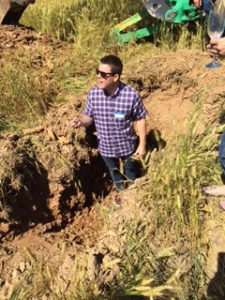
Drew Baker of Old Westminster in his Burnt Hill future vineyard soil pit
While listening to Drew Baker of Old Westminster Winery explain why they bought the property to plant fine red grapevines, we enjoyed Old Westminster’s pet nat sparkling gruener veltliner, which was dry, zesty and with more aroma and texture than you find in most still grueners. The nose was fascinating with lemon/lime and passion fruit aromas with some yeastiness, and the full palate was dry, with lots of volume finishing with creamy lemon.
Far from being a random piece of property, consultant geologist Bubba Beasley dug soil pits and helped them perform an 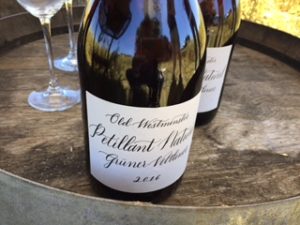 electromagnetic mapping of the soil on the property, and concluded that “This place has the potential to yield brilliant wines,” with which renowned viticulturist Lucie Morton concurred. At Old Westminster Winery itself, we enjoyed tasting their entire product range, some of which had just been bottled. The winery is a second generation business with Drew joined by his two sisters Lisa and Ashli who were all on hand to pour and explain the wines.
electromagnetic mapping of the soil on the property, and concluded that “This place has the potential to yield brilliant wines,” with which renowned viticulturist Lucie Morton concurred. At Old Westminster Winery itself, we enjoyed tasting their entire product range, some of which had just been bottled. The winery is a second generation business with Drew joined by his two sisters Lisa and Ashli who were all on hand to pour and explain the wines.
My highlights:
Old Westminster Winery Tasting Highlights
Greenstone 2016 58% viognier, 42% gruener veltliner grown on a limestone ridge. Nose: white flowers, lime, white peach. Palate; lively but solid, clean fruit, dry and delicate, very nice nuances of herbs, flowers and white stone fruits. Original, elegant and balanced. Native yeast fermented. $28
Birchwood Vineyard 2016, Carbonic maceration barbera. Nose: still reductive. Palate: very juicy and lively, high acid but lots of briar fruits, zesty and fun but needs decanting. $30
Anthem 2014. 53% cabernet franc, 27% cabernet sauvignon, 13% merlot, 7% syrah. Nose: wow – solid black fruits, nice spice notes but fruit-driven with spicy bacon nuances from syrah. Palate: smoky but rich, light and fresh, very elegant, light and easy to drink in surprise to the intensity of fruit on the palate.
Black 2014 30% merlot, 25% each cabernet franc and petit verdot, 12% syrah (unreleased).
Native yeast ferment, 18 mos. in new French oak. Nose: rich, ripe black fruits, the petit verdot stands out with lilac fragrance. Palate: firm acidity, smooth tannins, texture smooth, lively and fresh, very sexy and combines rich aromatics with elegant palate profile.
Following the Old Westminster tasting at the winery, we moved to their tank room where we tasted a group of other Maryland wineries’ wines.
Tasting Highlights 6/9, Other Wineries
New Market Plains Rosé 2016: An original and skillful blend of cabernet sauvignon and muscat blanc, 0.5% residual sugar. Nose: very fresh and floral fragrant, seems like it would taste very sweet. Palate: very fruity, but fine fruit/acid balance, pleasantly off-dry on the palate. Fun, a graduation present for moscato drinkers into real wine; clean and fresh.
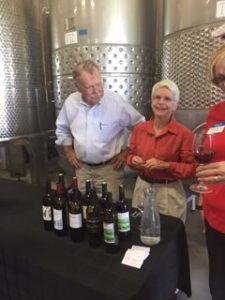
Robert Thompson and Joan Cartier of Link Bridge Vineyard with their vertical selection of cabernet franc wine
Link Bridge Vineyards features a one acre vineyard of fine cabernet franc in the Maryland Piedmont. They first sold grapes to Old Westminster Winery, who then helped them ferment their grapes to launch their own label. Their “rank amateur” 2010 (hobbyist wine) absolutely amazed me with its Old World style and varietal soul; the color was still opaque, and the nose had classic pencil lead, black cherries, truffles, antique wood and spice hints as if it were the best cabernet franc in the Loire Valley, or a varietal lot at Chateau Cheval Blanc. This made me a believer in their terroir! I thought of James Joyce (yes, yes.)
Link Bridge Vineyards Cabernet Franc 2013: Nose: much like the 2010 vintage, clean earth, truffles, and black cherry. Palate: lively, bright red and black cherry and loads of spice with bright firm acidity.
Harmony Vineyards is near the Mason-Dixon Line in Harford County. They make elegant, polished red Bordeaux blends, but I was most impressed with their varietal merlot (yes, even that).
Harmony Vineyards Merlot 2012 Nose: tightly wound, taught black fruits with mint and dark chocolate notes. Palate: firm mint/chocolate flavors with nice acidity. Original for the U.S. and reminiscent of Pomerol.
Black Ankle Vineyards
On June 10th following a lively evening at the Smoketown Brewing Station, a charming brewery in an old firehouse on the Potomac River, we went to Black Ankle Vineyards near Mt. Airy in the Linganore AVA for a tour and two (!) vertical tastings, held under a canopy outside the tasting room on a glorious (and hot) day with a view of the adjacent vineyard.
Melissa Schulte, Black Ankle’s general manager, hosted us on our tour. She explained that syrah, a major playor in the Black Ankle red program, has a worldwide problem called Syrah Decline, which tends to be worst in the best-performing clones of the classic Rhone grape, which makes its future problematic. She pointed out the Shur-Farm vertical frost protection machine, positioned at the lowest point in the vineyard, which sucks cold air, heats it, and blasts it vertically, providing an effective way to displace cold air in the vineyard with warm air.
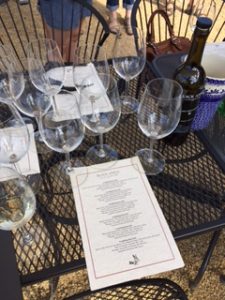
Tasting sheet for the Crumbling Rock vertical
Melissa also told us how important small lot production is to Black Ankle. In the lousy 2011 vintage, the press fraction helped save the vintage for them by delivering the tannins and other phenolics that the other lots, watered down by the rains, lacked.
Proprietors Ed and Sarah Boyce had generously arranged a vertical tasting of their signature meritage-style blend Crumbling Rock back to the original 2006 vintage (!) which won the top Maryland wine trophy. Here are tasting highlights from the entire event:
Black Ankle Vineyards
Albariño 2015: slightly spritzy, pale color. Nose: racy lime/mineral, white pepper and grapefruit zest. Palate: dry and racy but full-bodied, both racy and round; stylish. Five percent viognier.
Crumbling Rock (meritage-style) vertical:
2006 (38% cabernet franc, 24% cabernet sauvignon, 24% merlot, 5% petit verdot) Nose: bright red fruits, lively and fresh for 11 years old. Palate: firm tannins, fresh bright red cassis and cherry, zesty finish.
2007 (34% cabernet franc, 30% cabernet sauvignon, 22% merlot, 11% petit verdot, 3% syrah). Nose: hints of black fruits, but more backward than the open, forward 2006 with black and white pepper hints. Palate: rich, smooth, ripe black fruits, ripe tannins, fresh clean finish. High alcohol (14.9%) but well-integrated. Still young, a big West Coast style in a warm vintage, but fruit-driven.
2008 (57% cabernet franc, 21% cabernet sauvignon, 12% merlot, 8% petit verdot): Very characteristic of the vintage in Maryland and Virginia, a subtle minor key compared to 2007. Nose: mature, well-integrated dried cherries and currants, some clean earth and truffles. Palate: lively, fresh, fruit-driven, very claret-like in finesse and style. Fruit and earth elements in fine balance.
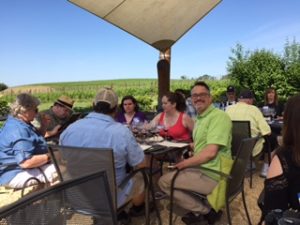
AWS Executive Director Dave Falcheck, about to taste the Crumbling Rock vertical
*2013 (54% cabernet sauvignon, 21% cabernet franc, 17% petit verdot, 8% merlot). Nose: fresh red fruits, mostly cassis, elegant and subtle. Palate: firm acid, ripe tannins, solid cassis, will age but enjoyable now, would go up against a classified Bordeaux growth.
Leafstone Vertical
Leafstone is Black Ankle’s syrah, very different in flavors and feel than the Crumbling Rock. Highlights are from 100% syrah wines.
2010: Nose: spicy plum and cherry, clean and fresh. Palate: zesty spice with white pepper which has large volume, with spice bigger than the fruit. Won’t age much longer, drink soon but special and distinctive.
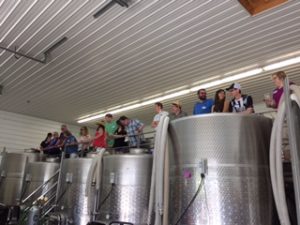
TasteCamp attendees exploring the catwalk in the Black Ankle tank room
2011: Nose: lively with spicy red cherry. Palate: high acid, firm tannins, solid black cherry. Outstanding quality for the vintage.
2013: Nose: wow! Wonderful balance of red fruits and spice. Palate: red cherry, spice but lovely smooth tannins.
Big Cork Vineyards, Washington Co.
Next we drove across South Mountain west of Frederick into the Cumberland Valley in Washington County, an extension of the Little Scotland Valley in Loudoun County, across the Potomac River. The temperature had been in the upper 80s when we left Mt. Airy but dropped into the upper 70s when we reached Big Cork Vineyards, sitting on a saddle between two ridges in the Cumberland Valley.
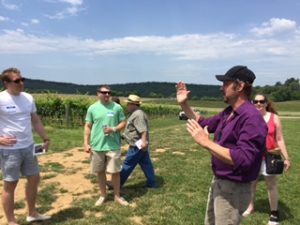
Winemaker Dave Collins of Big Cork explaining the vineyard soils and layout.
Big Cork Vineyards has a very contemporary design, and elegantly designed sitting areas between the winery and its hilltop vineyards giving a superior visitor experience, especially in hot weather. The winery is owned by Randy and Jennifer Thompson, with industry veteran Dave Collins in charge of the winemaking program. Dave was recruited by Randy when he was at Breaux Vineyards a few miles south of the Potomac River in Loudoun Co., Virginia, where he worked for many years.
Even while still at Breaux, Dave says he admired the elevation in Washington County and thought it had the potential to make classic wines. The dominant soil type is Catoctin Myersville, a broken shale soil that is well-drained and similar to the soils at Old Westminster and Black Ankle for its being well-drained and low-vigor. They now have 35 acres planted and can handle an additional 35 acres; Dave says they select cooler soils for white varieties and warmer soils for red varieties.
Big Cork Tasting Highlights
Sauvignon blanc 2016: almost colorless. Nose: flinty lime, a Loire Valley style, not obnoxious “cat pee” or passion fruit. Palate: dry but fresh, round, clean, not edgy, very stylish.
*Syrah Rosé 2016 (5% barbera): pale Provençal color. Nose: fragrant cherry blossoms. Palate: juicy, lovely red and white cherry flavors, smooth and forward, delicious and dry but not edgy.
*Reserve Malbec 2013: 30 mos. in French oak. Nose: classic boysenberry and sandlewood aromas but a nice balance of racy minerality and earth/truffle notes; intriguing. Palate: taut, vibrant acidity, blackberry fruit and truffle bass notes. Very young but promising and a fine reserve varietal example from a cool Mid-Atlantic site showing Western Maryland terroir very well.
Black Cat Port (black raspberry)
Inky ruby color. Nose—wow! Fresh and lively, clean and pure black raspberry! Palate: pure fruit, lively acidity, not too sweet, excellent fruit/acid balance.
Other Maryland Producers
As with Old Westminster, there was an industry-wide tasting of several other Maryland producers following the main winery tasting. Highlights:
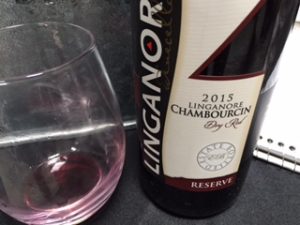 Linganore Cellars Dry Chambourcin 2015: The largest winery in the state is doing a fine job with the state’s signature non-vinifera red grape. Solid dark ruby color followed by a lovely nose of fresh black cherry. Palate: wonderfully lively fruit/acid balance, solid black cherry, dry and vibrant.
Linganore Cellars Dry Chambourcin 2015: The largest winery in the state is doing a fine job with the state’s signature non-vinifera red grape. Solid dark ruby color followed by a lovely nose of fresh black cherry. Palate: wonderfully lively fruit/acid balance, solid black cherry, dry and vibrant.
Antietam Creek Petit Verdot 2015: (25% merlot). This new winery isn’t open to the public but is very promising. This petit verdot has ighter color than usual but the nose doesn’t disappoint with clean plum, spice and lavender. On the palate, it’s smooth, with lively and juicy black fruits and lavender, firm spice on the finish. Fresh and lively, stylish.
*Catoctin Breeze Cabernet Franc 2015: The 2013 vintage of this wine took Best Red in the state. Nose: elegant red cherries and roses! Palate: smooth, spicy, lively and fresh—excellent singularity for this varietal.
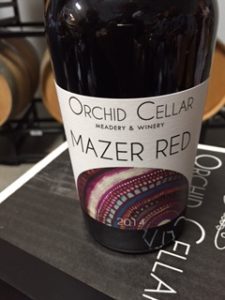 The surprise of the day was tasting the original and fine meads of Orchid Cellar Meadery & Winery west of Frederick.
The surprise of the day was tasting the original and fine meads of Orchid Cellar Meadery & Winery west of Frederick.
Orchid Cellars Mazer Red NV: pressed petit verdot skins are re-hydrated with a mixture of water and honey, fermented and then aged for two years in oak. Nose: an intriguing mixture of dried red fruits, lavender and honey, with like flavors on the palate and slight (favorable) oxidation and integration from extended oak aging. Mellow, halfway to a port yet refreshing and original, good for sipping instead of a higher alcohol beverage in the evening.
On the third day, attendees went to Boordy Vineyards, which I wrote a review about last February here.
Maryland TasteCamp Assessment
For about 20 years, from the mid-1980s to the mid-2000s, Maryland had eleven wineries while Virginia kept doubling its wineries every five years or so. With that growth in scale came a growth in quality and reputation, while Maryland’s wine industry seemed stuck in time.
As TasteCamp 2017 demonstrated, all that has changed. Today Maryland has some 65 wineries, beginning to follow Virginia’s pattern of doubling every five years or so. Some of these wineries also operate distilleries, and some don’t produce wine, but mead.
In addition to the welcome diversity, the search for quality and terroir is on the cutting edge, looking below the ground for ideal vineyard soil types, then matching for the optimal cultivar and rootstock. This is evident with some of the oldest Maryland wineries like Boordy who tore up virus-infected vines, re-planted on tight spacing, and also put in a long-term lease with a vineyard on South Mountain with en eye to finding the best site for ripening reds, but the same dynamic is happening with newer wineries like Big Cork and Old Westminster.
While producing some very trendy wines of the moment like pet nat sparklings and albariño, I was most impressed with the progress of Maryland red wines, especially the meritage blends. Long-time Maryland wine writer and Washington Post columnist Dave McIntyre agrees, noting that the reds are “much riper” now than they have been in the past, and the good news is that top Maryland producers also know what not to do, keeping the reds fresh and fruit-driven without too much oak.
“I knew there were enough good wines to DO TasteCamp in Maryland — but the wines really exceeded my expectations,” declares organizer Lenn Thompson. “And even more exciting was the variety. We tasted great albarino, sauvignon blanc, syrah, barbera, cabernet franc… the list goes on and on. There seems to be an emerging focus on Bordeaux-style blends and a lot of those wines were impressive. I’m curious if the next step — making distinctive versions of those wines that can only be made in Maryland — happens or if there will be another discovery or style that drives the region forward.”
There is terroir in Maryland, especially for red Bordeaux varieties. The mid-state Upper Piedmont region is a continuation of the terrain south of the Potomac River, with decomposing shale-based soils that are well-drained, low vigor, and on the right sites, Bordeaux-style red blends of classic style and fresh minerality. There’s no reason top Maryland reds can’t now take their place alongside the reds of Virginia and New York, and I’m grateful to TasteCamp for demonstrating it.
